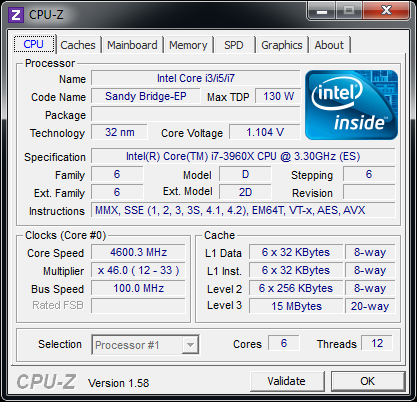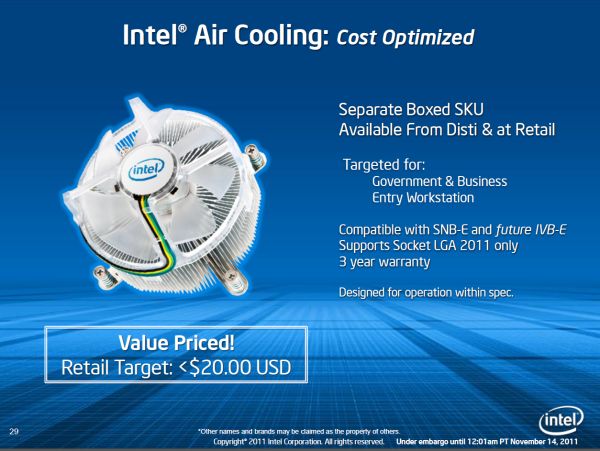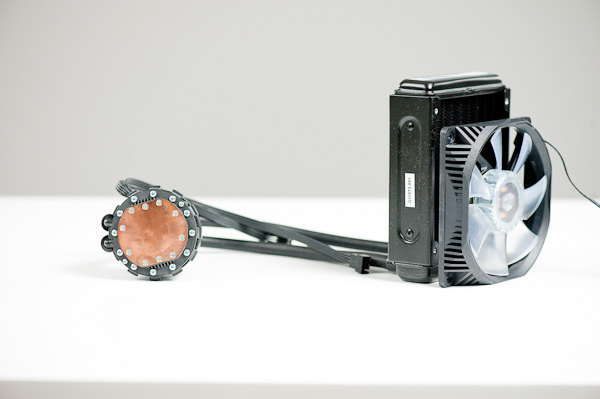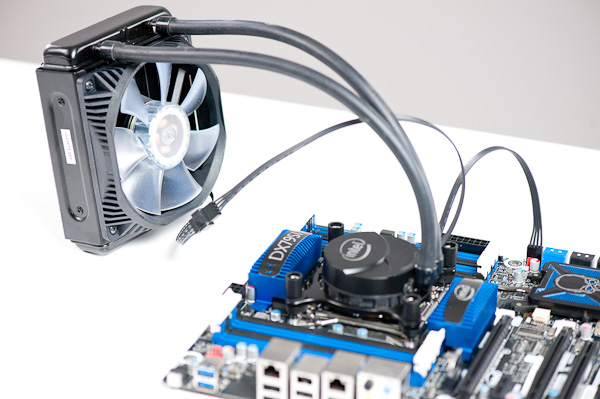Intel Core i7 3960X (Sandy Bridge E) Review: Keeping the High End Alive
by Anand Lal Shimpi on November 14, 2011 3:01 AM EST- Posted in
- CPUs
- Intel
- Core i7
- Sandy Bridge
- Sandy Bridge E
Overclocking
Sandy Bridge brought the motherboard's clock generator onto the 6-series chipset die. In doing so, Intel also locked its operation to 100MHz. While there was a bit of wiggle room, when combined with a locked processor, Intel effectively killed overclocking with most lower end Sandy Bridge chips.
For its more expensive CPUs, Intel offered either partially or fully unlocked (K-series) CPUs. The bus clock was still fixed at 100MHz, but you could overclock your processor by increasing its clock multiplier just like you could in the early days of overclocking.
With Sandy Bridge E, overclocking changes a bit. The clock generator is still mostly impervious to significant bus clock changes, however you're now able to send a multiple of its frequency to the CPU if you so desire. The options available are 100MHz, 125MHz, 166MHz and 250MHz.
Once again, wiggle room at any of these frequencies is limited so don't think we've moved back to the days of bus overclocking. You do get a little more flexibility, particularly with partially unlocked CPUs, but otherwise SNB-E overclocking is hardly any different from its predecessor.
Note that even if you select any of these options, the rest of the system still operates within spec. The multiplied bus clock is only fed to the CPU.

With a bit of effort I had no problems hitting 4.6GHz on my Core i7 3960X review sample. I had to increase core voltage from 1.104V to 1.44V, but the system was stable. While I could get into Windows at 4.8GHz and run a few benchmarks, the system wasn't completely stable.
No Cooler Included
None of the retail or OEM SNB-E parts include an Intel cooler in the bundle, a significant departure from previous CPUs. Presumably the cost of bundling a beefy cooler with these parts would've driven prices higher than Intel would've liked (remember you are getting a much larger die for roughly the same price as the outgoing Core i7 990X). Intel can also rationalize its decision against including any sort of cooler in the retail box by looking at the fact that many enthusiasts at this level opt for aftermarket cooling regardless.
Intel hasn't completely left SNB-E cooling up to 3rd party vendors however. There are two official Intel coolers available for use with SNB-E. The first is a < $20 heatsink that looks a lot like Intel's current coolers but with a couple of modifications (clear fan/shroud, retention screws instead of pegs). Intel states that this cooler is designed for operation within spec, meaning it could possibly limit overclocking attempts.

If you want an Intel branded overclocking solution, there's the RTS2011LC:

This is a closed loop liquid cooling solution similar to what AMD introduced alongside its Bulldozer CPU and similar to what many 3rd party cooling companies already offer. Intel expects its liquid cooling solution to be priced somewhere in the $85 - $100 range.
These closed loop liquid coolers are great primarily for getting away from the tower-of-metal heatsinks that have grown in popularity over the past several years. The radiator is a too small to compete with more traditional water cooling systems, but it can be a good gateway drug for the risk averse.











163 Comments
View All Comments
JlHADJOE - Tuesday, November 15, 2011 - link
On Page 2, 'The Pros and Cons':> Intel's current RST (Rapid Story Technology) drivers don't support X79,
Rapid Storage, perhaps?
jmelgaard - Tuesday, November 15, 2011 - link
Computers are only getting faster one way today, and that is more cores, designing for up to a strict number of cores is merely stupidity in today's world.That said, developing games that support multiple cores might be somewhat more difficult than designing highly concurrent applications that processes data or request for data. (I can't say for sure as I have only briefly touched the game development part of the industry, but I work with the other part on a daily basis)
But while you might save development cost right now going down that road, you will spent the savings ones you suddenly have to think 8 cores in.
Carrying technical debt is never a good thing (And designing with a set number of cores in mind can to my programming experience only add that), it will only get more expensive to remove down the road, that has been proven to be true again and again.
And that is even considering that Frostbite 3 might be developed from the ground up, they still have to think up the concept again, while had they gone for high concurrency, then that concept would already be in place for the next version.
TC2 - Tuesday, November 15, 2011 - link
note,BD 4x2bc ~ 2B elements, 315mm2
SB-E 6x2hc ~ 2.27B elements ~ +14%, 435mm2 ~ +38% (includes unused space for 2 more cores), up to 15MB cache, ...
impressive at all!
C300fans - Tuesday, November 15, 2011 - link
Intel Gulftown 6C 32nm 6 1.17B 240mm2Intel Sandy Bridge E (6C) 32nm 6 2.27B 435mm2
I dont see any impressive thing. any performance improves?
Blaster1618 - Tuesday, November 15, 2011 - link
Given QPI @ 3.2 Ghz 205 Gb/s (25.6 GB/s) also handled the PCI load, can't we have something in the middle. I'm still a little confused is DMI 2.0 still just mainly simple parallel interface where QPI is a high speed series interface?C300fans - Tuesday, November 15, 2011 - link
Just imagine DMI 1.0 is a 4pcs pci-e 1x 1.0.DMI 2.0 is a 4pcs pci-e 1x 2.0
jmelgaard - Tuesday, November 15, 2011 - link
Clearly you didn't read a single of my points, or simply lack the understanding.Applications are not developed to target specific cores, you OS handles all that, it is a simple matter of pushing out jobs in threads or processes.
Processing in 10, 100 or 1000 threads/processes is no more difficult than doing it in 4... it just requires you have enough "JOBS" to process (and that term was deliberately chosen)...
This requires a different mindset though, and this might be more difficult to think of games that way right now, mostly because they have been use to running everything in that single game loop, but doing it now could be a rather good ROI down the road.
DarkUltra - Tuesday, November 15, 2011 - link
How about overclocking with turbo boost enabled? I mean, if the 3960X is stable at 4.4GHz, can it be stable at 4.8GHz when games or applications only use four cores? Then it would overclock and perform as good as a 2600K with four heavy threads.yankeeDDL - Tuesday, November 15, 2011 - link
Guys, there are always people with more money than brain that will purchase just about anything.That's not the point. Having the fastest CPU makes it a status symbol and whoever makes it can have the luxury to price it in the $1000 range, for fools to buy.
I don't know about CPUs, but I do know that the top performing GPUs (HD6990 and GTX590) are sold in extremely low volumes, both because of the relatively low ROI, both because the market is so little that inventory are scarce to begin with.
So, you may be right on the CPU side, but in general, you're both wrong.
This said, my point was that if AMD had performed and delivered a good CPU, instead of the FX8150, OR, the FX8150 at a good price point ($170, not $279), then Intel would have had a tougher time in pushing out the 3960X for this price, AND, it would have had to work harder on the chipset. However, because of the huge lead it has over AMD, Intel now can comfortably rebrand a "mid range" chipset and shove it to the customer who has no choice but take it if they want the best CPU.
retoureddy - Wednesday, November 16, 2011 - link
I agree on the fact that only 2 6GB SATA ports are a disappointment. Interesting though is to run two SSD in RAID 0 on the intel controller. With two Kingston SSD I manage real good figures (Crystal Disk Mark) : 4000MB test -> 1040MB/s Read and 621MB/s Write in (SEQ) / 675 and 481 (512K) / 28 and 253 (4K) / 279 and 405 4K QD32. I never managed this kind of throughput on the Z68 or P67 on-board controllers. These numbers are getting close to hardware RAID controllers like ARECA and LSI. I would have been interested to see where the bottleneck lies if X79 would have had more ports. Even though X58 is 3GB Sata you had no problem bottle-necking the Intel RAID controller at around 800MB/s.